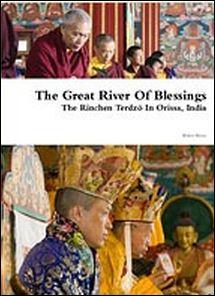
The Great River Of Blessings with the subtitle The Rinchen Terdzö in Orissa, India is an account of the Rinchen Terdzö conferred by Tertön Namkha Drimed Rinpoche on Sakyong Mipham Rinpoche in the winter of 2008-2009. The Rinchen Terdzö holds some of the most vital practices and instructions held by the Nyingma lineage of Tibetan Buddhism. Namkha Drimed Rinpoche received the Rinchen Terdzö directly from Chögyam Trungpa Rinpoche, and Walker Blaine wrote this book. Rinchen Terdzö is the accumulated terma transmissions known up to this day collected in a compilation. To receive the instructions, one has to spend at least a quarter of a year – but you could also read this book:
 The Great River Of Blessings
The Great River Of Blessings
What are Terma Transmissions in Tibetan Buddhism?
In Tibetan Buddhism, “terma” refers to a category of revelatory literature, often seen as sacred texts or objects, that were said to have been hidden away for future discovery. The concept of terma and the process of its discovery are particularly associated with the Nyingma school, but they can be found in various forms across all schools of Tibetan Buddhism.
The term “terma” literally means “treasure,” and these treasures are often believed to have been concealed by Padmasambhava (often known as Guru Rinpoche), a seminal figure in the spread of Buddhism in Tibet during the 8th century, and his close disciples. These treasures were hidden in both physical locations (such as caves or under rocks) and in the mindstreams of his main disciples, to be revealed at a later, more propitious time.
The individuals discovering termas are called “tertöns” or “treasure revealers.” These tertöns are believed to be reincarnations of the original disciples of Padmasambhava who received the teachings and then hid them. The appearance of tertöns and their discoveries of termas often come when the teachings are particularly needed or when there’s a decline in the spiritual practice.
There are two main types of termas:
- Earth Treasures (Sa Ter): These are physical objects such as texts, statues, or ritual items that are found in specific locations, often indicated in prophetic guidebooks or through the tertön’s visions.
- Mind Treasures (Gong Ter): These are teachings or practices that are revealed through the tertön’s own mind or visions, often during dreams or deep meditative states. It is believed that these teachings are the result of the direct transmission from Guru Rinpoche or other enlightened beings.
Terma transmissions play a significant role in maintaining the vitality and relevance of Tibetan Buddhism. They are seen as a means by which the teachings can be refreshed and adapted to the needs of the time. Over the centuries, numerous termas have been discovered and have significantly influenced the various traditions of Tibetan Buddhism.
